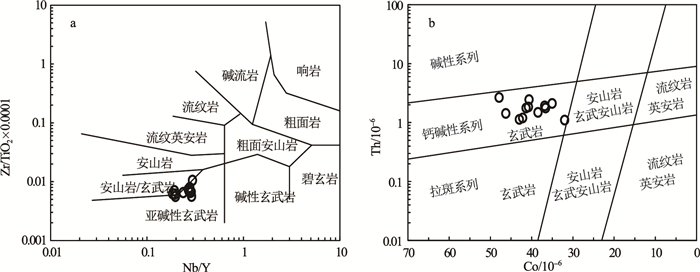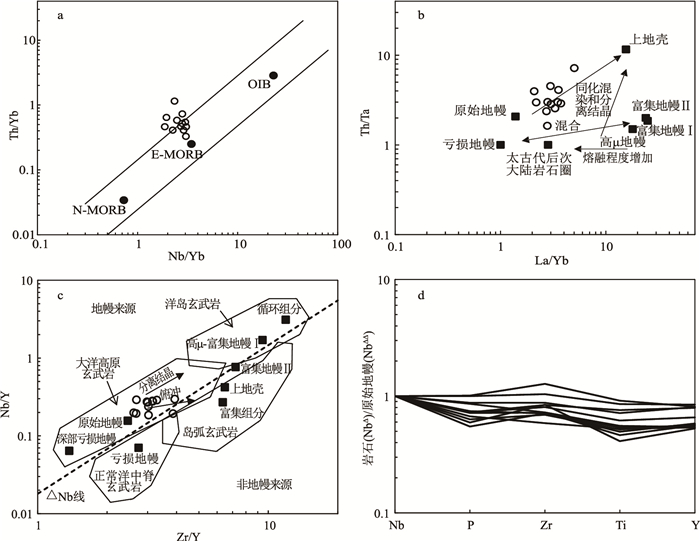Petrology and geochemistry of the eclogite in Heihe area of Lancang County, western Yunnan: the magmatism of the initial subduction of the oceanic crust
-
摘要:
滇西澜沧黑河地区厘定的奥陶纪谦迈蛇绿混杂岩是区域上勐库地区湾河蛇绿混杂岩的南延部分,是原特提斯洋盆关闭后的残迹;其中发育规模不等的榴辉岩构造岩片。榴辉岩经历了多期不同程度的退变质作用,可见丰富的退变质结构,主要榴辉岩相的变质矿物有石榴子石、绿辉石、多硅白云母、金红石等。岩石的SiO2含量为49.76%~52.71%,TiO2为1.12%~1.96%,Al2O3为14.18%~16.92%,CaO为7.91%~10.04%,MgO为5.93%~9.14%,Na2O为2.81%~4.77%,K2O为0.09%~1.15%,Mg#=56~69,表明岩浆的分异演化程度较低,接近原始岩浆,总体特点类似前弧玄武岩。稀土元素配分曲线向右缓倾,轻稀土元素轻度富集,(La/Sm)N=1.13~2.05,(Gd/Yb)N=1.18~1.56,与E-MORB(富集型洋中脊玄武岩)类似。微量元素特征表明,其原岩为一套富Nb玄武岩,来自富集地幔源区。总之,黑河地区榴辉岩的原岩属前弧玄武岩,是洋壳初始俯冲阶段的产物,代表了原特提斯洋盆由扩张向俯冲消减转换的岩石学记录。
Abstract:The Ordovician Qianmai ophiolitic melange in the Heihe area of Lancang, western Yunnan, is the southern extension of the Wanhe ophiolitic melange in Mengku region, which is the remnant of the closure of the original Tethyan oceanic basin, where some eclogite tectonic slices of different scales are also developed. The eclogite experienced many stages of retrograde metamorphism in different degrees, with abundant retrograde metamorphic structures. The metamorphic minerals of eclogite facies are garnet, omphacite, polysilicate muscovite and rutile, etc. It is chemically characterized by SiO2 content of 49.76%~52.71%, TiO2 content of 1.12%~1.96%, Al2O3 content of 14.18%~16.92%, CaO content of 7.91%~10.04%, MgO content of 5.93%~9.14%, Na2O content of 2.81%~4.77%, K2O content of 0.09%~1.15% and Mg# values of 56~69, indicating that the magma has a low degree of differentiation and evolution, close to the primitive magma and similar to front arc basalt(FAB). The distribution curve of rare earth elements inclines gently to the right, and LREE is slightly enriched. The (La/Sm)N content ranges from 1.13 to 2.05, and (Gd/Yb)N content ranges from 1.18 to 1.56, similar to that of enriched mid-ocean ridge basalt(E-MORB). The trace elements indicate that the protolith is a set of Nb-enriched basalts from the source area of enriched mantle. In a word, the protolith of retrograde eclogite in the Heihe area belongs to FAB, which is the product of the initial subduction of the oceanic crust, and represents the petrological records of the transformation from expansion to subduction of the original Tethyan oceanic basin.
-
Key words:
- petrology /
- geochemistry /
- eclogite /
- Proto-Tethys Ocean /
- front arc basalt /
- Lancang County of western Yunnan
-

-
图 3 黑河地区榴辉岩稀土元素球粒陨石标准化配分模式图(a)和原始地幔标准化微量元素蛛网图(b)(N-MORB、E-MORB、OIB数据及标准化值均据参考文献[18])
Figure 3.
表 1 黑河地区榴辉岩主量、微量和稀土元素分析成果
Table 1. Major, trace element and REE contents of the eclogite in the Heihe area
编号 D2540-1 PM008 -2-1 PM008 -37-1 PM008 -50-1 PM008 -31-2 PM00 8-47-2 PM008 -48-1 PM008 -51-3 PM008 -53-1 PM008 83-2 PM021 -13-1 PM021 -21-2 SiO2 49.94 52.27 51.04 52.71 49.76 51.87 51.10 50.01 51.23 50.33 49.77 50.23 TiO2 1.16 1.67 1.72 1.23 1.56 1.47 1.12 1.63 1.64 1.56 1.55 1.96 Al2O3 16.92 14.62 14.46 14.91 14.71 15.17 15.15 15.11 14.18 14.97 15.88 15.04 Fe2O3 3.10 3.57 3.41 2.75 3.69 3.40 3.35 3.47 3.71 3.22 3.77 3.92 FeO 6.97 7.55 7.37 6.02 8.11 7.12 6.50 7.93 8.42 7.43 8.04 8.48 MnO 0.23 0.21 0.23 0.21 0.19 0.21 0.19 0.25 0.23 0.21 0.21 0.22 MgO 8.47 6.59 6.71 7.29 6.90 5.93 7.60 8.19 6.04 9.14 7.39 6.67 CaO 8.30 8.12 9.76 10.04 9.74 9.37 8.99 8.41 9.56 8.37 7.91 8.01 Na2O 3.25 3.20 4.12 3.57 3.84 4.26 4.77 3.78 3.36 2.81 3.57 3.75 K2O 0.75 1.15 0.14 0.47 0.36 0.20 0.34 0.09 0.49 0.96 0.87 0.54 P2O5 0.12 0.21 0.22 0.14 0.23 0.21 0.17 0.25 0.20 0.17 0.15 0.23 Mg# 69 61 62 69 60 60 68 65 56 69 62 59 Zr 76.01 102.17 97.17 80.32 114.43 154.15 88.57 108.34 112.70 109.02 86.75 121.92 Zn 126.98 101.34 105.73 126.37 98.03 113.53 99.22 89.26 112.93 76.16 93.54 108.09 V 258.90 338.88 316.15 241.96 316.11 296.79 240.20 337.85 340.66 221.21 291.94 298.96 Th 1.76 2.44 1.13 1.48 1.76 2.10 1.10 1.43 1.92 2.66 1.20 1.83 Sc 39.62 43.18 38.39 33.68 37.38 35.55 35.03 36.39 38.88 32.16 38.10 37.95 Sr 236.97 116.74 95.07 176.55 79.16 172.81 106.41 105.08 96.96 187.61 99.69 81.94 Rb 43.26 74.01 4.05 13.03 12.18 8.51 10.68 4.99 14.17 43.94 40.26 28.47 Ni 64.94 58.37 88.87 108.33 92.99 59.29 130.10 97.63 29.11 205.33 55.36 90.37 Nb 6.79 7.41 10.51 6.32 10.25 11.61 7.80 9.48 10.34 5.43 6.56 7.45 Cu 48.55 55.38 60.10 50.86 44.03 52.96 59.25 197.07 38.84 45.34 39.45 48.00 Cr 189.90 191.79 187.20 262.60 230.04 146.07 305.86 247.55 30.70 547.44 75.94 231.75 Co 41.34 40.63 42.96 38.45 36.62 35.03 32.00 46.25 36.82 47.90 42.19 40.77 Ba 129.66 326.74 66.27 148.90 118.98 49.51 109.58 10.87 167.09 305.14 447.97 101.62 Hf 1.98 3.21 2.80 2.33 2.98 4.04 2.23 2.93 3.14 2.84 2.45 3.42 Ta 0.43 0.54 0.69 0.51 0.62 0.70 0.43 0.60 0.64 0.37 0.40 0.46 U 0.44 0.59 0.32 0.29 0.55 0.86 0.22 0.36 0.52 0.60 0.34 0.41 Pb 34.95 7.73 5.59 18.33 3.67 3.10 2.48 3.95 12.71 7.37 17.68 4.99 Be 3.49 1.08 1.20 1.04 0.91 1.05 1.01 1.17 1.06 1.66 0.87 0.76 La 8.62 11.36 9.62 9.56 11.38 13.56 8.89 8.47 10.38 11.63 6.36 8.32 Ce 17.45 25.50 22.19 21.37 25.68 30.84 20.34 19.65 23.22 25.28 15.50 20.35 Pr 2.12 3.55 3.05 2.79 3.53 4.10 2.73 2.71 3.23 3.41 2.22 2.97 Nd 9.65 16.24 14.36 12.88 16.11 18.49 13.05 12.69 15.24 15.27 11.24 15.10 Sm 2.64 4.62 4.19 3.66 4.38 5.09 3.34 3.93 4.23 3.73 3.53 4.40 Eu 1.36 1.46 1.40 1.32 1.54 1.61 1.23 1.35 1.55 1.41 1.32 1.72 Gd 3.53 5.61 5.37 4.32 5.81 6.08 4.11 4.82 5.54 4.48 4.92 6.01 Tb 0.61 0.95 0.90 0.71 0.98 1.08 0.75 0.86 0.95 0.76 0.84 1.04 Dy 3.80 6.53 6.26 4.60 6.45 6.76 4.94 5.66 6.50 4.63 5.78 7.09 Ho 0.80 1.32 1.24 0.95 1.34 1.36 0.92 1.17 1.30 0.92 1.17 1.42 Er 2.43 3.94 3.65 2.68 3.98 4.10 2.96 3.50 4.00 2.66 3.33 4.07 Tm 0.38 0.60 0.55 0.41 0.55 0.60 0.43 0.49 0.57 0.41 0.53 0.64 Yb 2.42 3.81 3.45 2.55 3.77 3.87 2.70 3.10 3.70 2.32 2.92 3.98 Lu 0.35 0.56 0.52 0.37 0.56 0.59 0.43 0.48 0.58 0.39 0.53 0.63 Y 24.18 38.22 36.23 26.58 38.14 39.24 28.04 32.95 37.86 28.22 33.24 40.31 ∑REE 56.17 86.04 76.76 68.17 86.07 98.12 66.83 68.88 80.97 77.29 60.17 77.74 δEu 1.36 0.88 0.91 1.01 0.93 0.88 1.02 0.95 0.98 1.06 0.97 1.02 δCe 0.97 0.98 1.00 1.00 0.99 1.00 1.00 1.00 0.98 0.97 1.01 1.00 (La/Yb)N 2.55 2.14 2.00 2.69 2.16 2.51 2.36 1.96 2.01 3.60 1.56 1.50 (La/Sm)N 2.10 1.59 1.48 1.69 1.68 1.72 1.72 1.39 1.58 2.01 1.16 1.22 (Gd/Yb)N 1.20 1.22 1.29 1.40 1.27 1.30 1.26 1.29 1.24 1.60 1.39 1.25 注:原始分析数据按11项氧化物进行标准化,然后按里特曼法进行全铁调整;主量元素含量单位为%,微量和稀土元素含量单位为10-6 -
[1] 刘本培, 冯庆来, 方念乔. 滇西昌宁-孟连带和澜沧江带古特提斯多岛洋构造演化[J]. 地球科学, 1993, 18(5): 529-539. https://www.cnki.com.cn/Article/CJFDTOTAL-DQKX199305000.htm
[2] 莫宣学, 路风香, 沈上越, 等. 三江特提斯火山作用与成矿[M]. 北京: 地质出版社, 1993: 1-67.
[3] 潘桂棠, 陈智, 李兴振, 等. 东特提斯地质构造形成演化[M]. 北京: 地质出版社, 1997: 1-179.
[4] 钟大赉. 川滇西部古特提斯造山带[M]. 北京: 科学出版社, 1998: 1-231.
[5] 崔春龙, 曾允孚, 段丽兰, 等. 滇西昌宁-孟连带存在一个古生代大洋吗?[J]. 沉积学报, 1999, 17(2): 176-181. doi: 10.3969/j.issn.1000-0550.1999.02.002
[6] 朱勤文, 张双全. 滇西南曼信夭折堆积岩的确认及其意义[J]. 地质科技情报, 1999, 18(2): 1-3. doi: 10.3969/j.issn.1000-7849.1999.02.001
[7] 李静. 云南省双江县石炭纪牛井山蛇绿混杂岩的岩石学研究[D]. 昆明理工大学硕士学位论文, 2003.
[8] 段向东. 滇西南耿马地区昌宁-孟连带盆地演化[D]. 中国地质大学(武汉)博士学位论文, 2008.
[9] 李静, 孙载波, 黄亮, 等. 滇西勐库退变质榴辉岩P-T-t轨迹及地质意义[J]. 岩石学报, 2017, 33(7): 2285-2291. https://www.cnki.com.cn/Article/CJFDTOTAL-YSXB201707022.htm
[10] 王保弟, 王立全, 王冬兵, 等. 三江昌宁-孟连带原-古特提斯构造演化[J]. 地球科学, 2018, 43(8): 5-28. https://www.cnki.com.cn/Article/CJFDTOTAL-DQKX201808001.htm
[11] 刘桂春, 孙载波, 曾文涛, 等. 滇西双江县勐库地区湾河蛇绿混杂岩的厘定、地球化学特征及其地质意义[J]. 岩石矿物学杂志, 2017, 36(2): 163-174. https://www.cnki.com.cn/Article/CJFDTOTAL-YSKW201702003.htm
[12] 王冬兵, 罗亮, 唐渊, 等. 昌宁-孟连结合带牛井山早古生代埃达克岩锆石U-Pb年龄、岩石成因及其地质意义[J]. 岩石学报, 2016, 32(8): 2317-2329. https://www.cnki.com.cn/Article/CJFDTOTAL-YSXB201608006.htm
[13] 孙载波, 李静, 周坤, 等. 滇西勐库地区退变质榴辉岩锆石U-Pb年龄及其地质意义[J]. 地质通报, 2018, 37(11): 2032-2043. http://dzhtb.cgs.cn/gbc/ch/reader/view_abstract.aspx?file_no=20181109&flag=1
[14] 孙载波, 李静, 周坤, 等. 滇西双江县勐库地区退变质榴辉岩的岩石地球化学特征及其地质意义[J]. 岩石矿物学杂志, 2017, 31(4): 746-756. https://www.cnki.com.cn/Article/CJFDTOTAL-XDDZ201704009.htm
[15] 孙载波, 胡绍斌, 周坤, 等. 滇西南澜沧谦迈地区榴辉岩岩石学、矿物学特征及变质演化P-T轨迹[J]. 地质通报, 2019, 38(7): 1105-1115. http://dzhtb.cgs.cn/gbc/ch/reader/view_abstract.aspx?file_no=20190704&flag=1
[16] 肖庆辉, 李廷栋, 潘桂棠, 等. 识别洋-陆转换的岩石学思路——洋内弧与初始俯冲的识别[J]. 中国地质, 2016, 43(3): 721-737. https://www.cnki.com.cn/Article/CJFDTOTAL-DIZI201603003.htm
[17] Shatsky V S, Kozmenko O A, Soblev N V. Behaviour of arreearth elements during high-pressure metamorphism[J]. Lithos, 1990, 25: 219-226. doi: 10.1016/0024-4937(90)90017-U
[18] Sun S, MacDonough W F. Chemical and isotopic systematics of oceanic basalts: implications for mantle composition and processes[J]. Geological Society London, Special Publications, 1989, 42: 313-345. doi: 10.1144/GSL.SP.1989.042.01.19
[19] Winchester J A, Floyd P A. Geochemical discrimination of different magma series and their differentiation products using immobile elements[J]. Chemical Geology, 1977, 20(4): 325-343. http://www.sciencedirect.com/science/article/pii/0009254177900572
[20] Hastie A R, Kerr A C, Pearce J A, et al. Classification of altered volcanic island arc rocks using immobile trace elements: Development of the Th-Co discrimination diagram[J]. Journal of Petrology, 2007, 48(12): 2341-2357. doi: 10.1093/petrology/egm062
[21] Pearce J A. Petrogenetic implications of Ti, Zr, Y and Nb variations in volcanic rocks[J]. Contributions to Mineralogy & Petrology, 1979, 69(1): 33-47. http://onlinelibrary.wiley.com/resolve/reference/XREF?id=10.1007/BF00375192
[22] Wood D A. The application of a Th-Hf-Ta diagram to problems of tectonomagmatic classification and to establishing the nature of crustal contamination of basaltic lavas of the British Tertiary Volcanic Province[J]. Earth & Planetary Science Letters, 1980, 50(1): 11-30. http://www.sciencedirect.com/science/article/pii/0012821X80901168
[23] Pearce J A. Geochemical fingerprinting of oceanic basalts with applications to ophiolite classification and the search for Archean oceanic crust[J]. Lithos, 2008, 100(1): 14-48. http://www.sciencedirect.com/science/article/pii/S0024493707001375
[24] Pearce J A, Stern R J, Bloomer S H, et al. Geochemical mapping of the Mariana arc-basin system: Implications for the nature and distribution of subduction components[J]. Geochemistry Geophysics Geosystems, 2013, 6(7): 1-27. http://onlinelibrary.wiley.com/doi/10.1029/2004GC000895
[25] Condie K C. High field strength element ratios in Archean basalts: a window to evolving sources of mantle plumes?[J]. Lithos, 2005, 79(3): 491-504. http://www.sciencedirect.com/science/article/pii/S0024493704003202
[26] Myers R E, Breitkopf J H. Basalt geochemistry and tectonic settings: A new approach to relate tectonic and magmatic processes[J]. Lithos, 1989, 23(1/2): 53-62. http://www.sciencedirect.com/science/article/pii/0024493789900224
[27] Breitkopf J H. Geochemical evidence for magma source heterogeneity and activity of a mantle plume during advanced rifting in the southern Damara Orogen, Namibia[J]. Lithos, 1989, 23(1/2): 115-122. http://www.sciencedirect.com/science/article/pii/0024493789900261
[28] 彭智敏, 张辑, 关俊雷, 等. 滇西"三江"地区临沧花岗岩基早-中奥陶世花岗质片麻岩的发现及其意义[J]. 地球科学, 2018, 43(8): 49-63. https://www.cnki.com.cn/Article/CJFDTOTAL-DQKX201808003.htm
[29] 刘桂春, 孙载波, 曾文涛, 等. 滇西双江县勐库地区湾河蛇绿混杂岩的厘定、地球化学特征及其地质意义[J]. 岩石矿物学杂志, 2017, 36(2): 163-174. https://www.cnki.com.cn/Article/CJFDTOTAL-YSKW201702003.htm
[30] Xing X, Wang Y, Cawood P A, et al. Early Paleozoic accretionary orogenesis along northern margin of Gondwana constrained by high-Mg metaigneous rocks, SW Yunnan[J]. International Journal of Earth Sciences, 2017, 106(5): 1469-1486. doi: 10.1007/s00531-015-1282-z
-




 下载:
下载:




